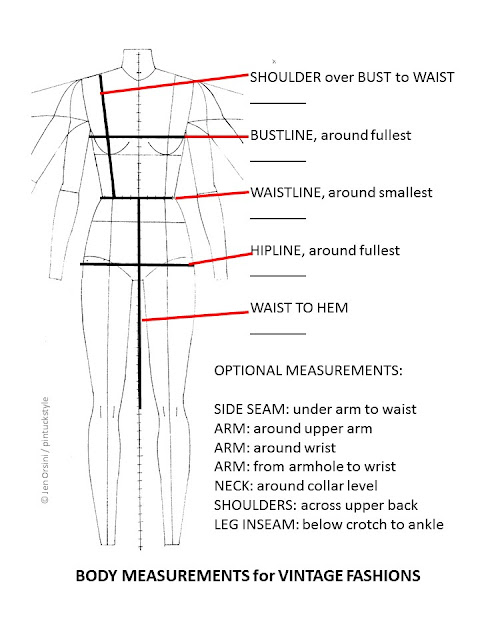Home
▼
Monday, May 23, 2016
Vintage & Modern Sizes: Measurement Chart
How can you find your size in vintage fashion? Interesting fact: did you know that there are NO STANDARD sizes in the US? That's right! Every brand can use their own sizing. But many brands have sizes that are almost the same, and that's what I used for the MEASUREMENT CHART here.
In shopping online, for vintage or current styles, we need to rely on measurements, instead of sizes. The vintage fashion measurement chart here will help you find your best fit. Because older fashions are sized differently than the clothes we buy and wear today it's hard to know what to look for when shopping for vintage. Understanding current fashion sizes and measurements can help when selecting vintage fashion in your size.
BODY MEASUREMENTS for VINTAGE FASHIONS
Using the first chart, take your body measurements. It helps to have someone do that for you so the measuring tape is level. Don't make the tape too loose or too tight.
Bustline: measure around the fullest areas to get the best fit.
Waistline: measure around the natural waistline. To find your waistline, try tying a length of elastic around your waist, it will settle in at the smallest measurement.
Hipline: measure around the fullest part of your hips or thighs. If this is a problem area for you also measure how far BELOW the WAISTLINE the measurement was taken.
Shoulder over Bustline to Waist: start at the center of the shoulder, this will give a good length for a dress or blouse bodice. If the dress has no waistline seam, then measure to the hem.
Waist to Hem: find the skirt length you want and measure that down center front.
There are also optional measurements included. Use them if you have ongoing fit problems in a specific area.
SIZE & MEASUREMENT CHART
Below is a new updated modern commercial size chart that I developed from several top websites using both inches and centimeters (inches/centimeters). You can use this chart in several ways:
1) Check your own measurements with this chart to see your standard size in modern fashion.
2) Look up your current size, and find the measurement range, then take your own measurements to be sure.
3) If you are selling vintage or creating new fashion items, use this chart when you list it so your customers can find their own size.
RULE #1: Know your own body measurements.
RULE #2: Measure your own vintage fashions that fit best.
Use those garment measurements as a guide when shopping for similar fashions online.
RULE #3: Always add wearing ease when comparing your measurements to a fashion garment.
What is this?
Have enough extra 'wiggle room' in the garment so you can move and breathe!
Be sure that it is at least 2" or more larger in the bust than your own bust line and 4" or more larger in the hips than your own hip line.
A few things to expect when shopping for vintage:
**Our waistlines are bigger, so if this is you:
Expect vintage waistlines to be 'too small' in the waist if they don't have elastic stretch.
(You can let out back darts in most styles for a bit more waistline room) and shop by your WAIST measurement to find a good fit.
**Our Bustline and Back measurements are larger, so if this is you:
Expect bustlines to be tight even when the waistline and hips do fit and shop by your BUST measurement to find a good fit.
**Vintage fabric rarely stretches, so
Don't expect your vintage fashion to have more stretch room than it measures.
**Remember to wear foundation and undergarments suitable to the style, and you'll have that gorgeous vintage fashion for years to come!


